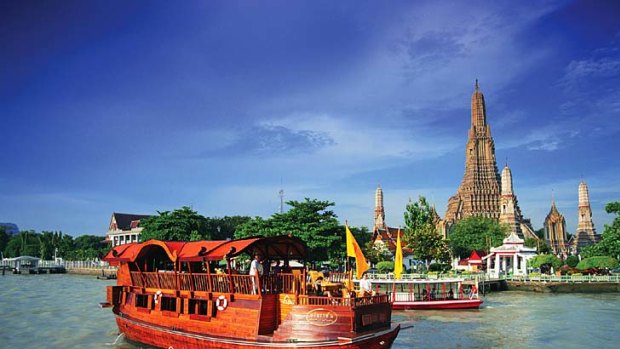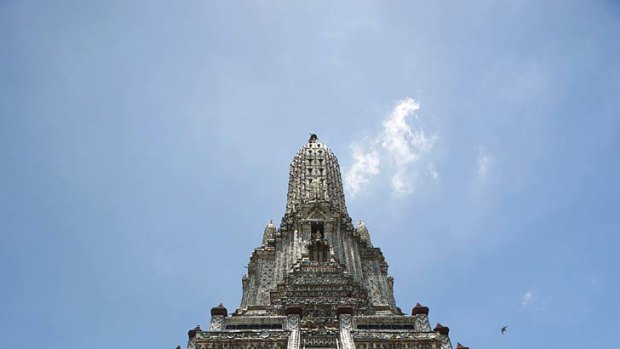
River highway ... the Anantara Dream.
Leisa Tyler boards a restored rice barge for a leisurely cruise from the heart of Bangkok to a lost imperial city.
Years before Bangkok became choked with traffic and flyovers, people used the Chao Praya River for transport and trade. This great snake of water flows for 372 kilometres from Nakhon Sawan, a small town in Thailand's central plains, to the Gulf of Thailand. Carrying the colour of the rich agricultural land and rice fields it feeds, the river links some of Thailand's most important temples and ancient cities, including Ayutthaya, the Siam empire's illustrious capital for four centuries, and Rattanakosin, the historic heart of Bangkok.
Past kings and their kinsmen would visit these religious edifices in a procession of boats. These days most people visit them by car and can travel by highway in an hour.
Hoping to revive the glory days of slow travel, Thai resort group Anantara has begun cruises between Bangkok and Ayutthaya on two century-old teak rice barges. . Both barges are carefully restored, with polished wood panelling, spacious indoor and outdoor lounge areas, airconditioned staterooms, private baths and chirpy crews with a manager, butler, captain and cook.
We board the two-stateroom Anantara Dream, moored at the Anantara Bangkok Riverside Resort and Spa, formerly a Marriott but reopened in November, and sail through the city's morning fumes and fury. Pencil-thin red and yellow river taxis strung with garlands of jasmine careen between belching ferries and coal-loaded cargo rafts pulled by yellow tugs. Tourists on sleek sightseeing boats jostle to photograph our antiquated vessel. On our left are a clutch of luxury riverside hotels, their cobalt-blue swimming pools nudging the water. On the right, apartment buildings tower over cheap riverside restaurants serving infernal Thai salads and salt-grilled fish plucked from the ocean, a few kilometres downstream.
We pull up at a temple that outdates it all. With white stucco walls and a sunflower-yellow peaked roof topped by gilded spires, at a glance Kalayanamit Varamahavihara Temple looks like the other thousand or so Buddhist temples that pepper Bangkok. But look closer and it's remarkably Chinese. Built by Chinese traders in the early 19th century, it was believed that only after you stepped through the stone gates, guarded by Taoist demigods, could you be sure of a safe journey home. It was built during rapid colonial expansion in Asia, when many Thais saw China's growing influence in Bangkok as a relief from the Europeans.

Wat Arun, one of Bangkok's landmarks.Credit: Leisa Tyler
Next door the unmistakable steel-grey spires of Wat Arun, otherwise known as the Temple of Dawn, were built as a landmark during the Ayutthaya period to alert sailors that they had arrived in Bangkok. It is meant to resemble Mount Meru, the mountain at the centre of the universe in Buddhist and Hindu philosophies.
As we continue up the river, a colossal plate of pad thai, Thailand's legendary Chinese-inspired noodles tossed with egg, garlic shoots, smoked tofu and prawns, is served in the dining room. It would have been nice to sit outside but the temperature has hit the mid-30s and the sun has turned the front deck into a sauna.
Eventually, skyscrapers give way to suburbs of colourful stilted wooden houses hanging gingerly over the river, their balconies overhung with bougainvillea and frangipani. Children fish from old wooden jetties. We stop to throw bread to a school of plump catfish residing in front of a temple; Thailand's Theravada Buddhism forbids killing and it seems the fish know where they are safe from the fisherboys' hooks.
You couldn't call the Chao Praya a pretty river. Flat, monotonous and, in its lower reaches, peppered with cement factories belching white dust, it is no rival to the Mekong, Thailand's other great river. We squeeze beneath several bridges, sometimes barely; the river is swollen from the monsoonal rains that have caused havoc in Ayutthaya and the northern outskirts of Bangkok. It's not until the sun begins to set and the barge has anchored for the night that it's possible to claim a deck chair and, with a bottle of wine, absorb the serenity and peace of the river.
When King U Thong established the capital of Ayutthaya in 1350, he chose a site at the auspicious confluence of three rivers - the Pa Sak, Chao Phraya and Lopburi - and built a small canal around the city to turn it into an easily defensible island.
Ayutthaya flourished; in its 16th-century heyday, more than 500 gold-spired temples peppered the city-island, alongside expansive palaces, hectares of brick chedis (used as burial graves) and scores of gold and jade Buddha statues. The city's location - midway between China, India and the Malay Archipelago - made it a popular trade hub for silk, tea and spices. Dignitaries from Holland, France and India built missions here and, with a population of 1 million, Ayutthaya was one of the largest cities in the world.
In 1767 Ayutthaya was attacked by Burma's Konbaung Dynasty, an old rival of the Siamese. The siege lasted a year. Ayutthaya's guards finally gave up and the Burmese stormed the city on a squadron of elephants. They raped, looted and set Ayutthaya alight, trashing its lovely old temples and palaces, destroying Buddha statues and seizing the gold and gems (gold from the main palace furnished the crown on Shwedagon Pagoda in the Burmese capital). Devastated by the destruction, the Siam Empire moved its capital to Rattanakosin, which is modern-day Bangkok.
Of Ayutthaya's 500 original temples, the traces of only 168 remain, scattered over a flat expanse bordered by canals and rows of trees that predate the Burmese ambush. The lost city doesn't have the splendour of the first Siamese capital, Sukhothai, to the north, or Angkor in Cambodia. Nor are the remains in good condition - concrete has been used to patch some temples, tree roots are forcing others apart.
The October floods deposited mounds of debris throughout the temples and stupas, further weakening their foundations. But despite the neglect, it's impossible not to be in awe of what once lay here, by the sheer size and grandeur of the reception halls, the huge number of chedis and the majesty of the Buddha statues, their faces calm and serene amid the rubble. It reeks of sadness and regret, of tragedies and past glories.
You could easily spend a week in Ayutthaya, coming out in the early morning and late afternoon to avoid the sweltering noon sun and throngs of tourist buses. You could visit the chedi that holds Queen Suriyothai's ashes, the great feminist who, in one battle with the Burmese, dressed in a man's clothing to fight alongside her husband and died saving his life.
Wat Phananchoeng flanks the confluence of the rivers and has a 19-metre-high Buddha statue. Built in 1324, before the Ayutthaya period, it's perpetually busy with well-wishers lighting incense sticks and in prayer, sitting with legs folded neatly to one side, hands pressed together and reciting mantras.
Further south, Bang Pa-In Summer Palace was established as a royal retreat for the kings of Ayutthaya. Restored and expanded by the current King Bhumiphol, these days it feels more like a Disneyfied United Nations, with a zoo full of Versailles-style hedges pruned into animal shapes, a Swiss chalet and a kitsch two-storey Chinese palace presented to King Chulalongkorn by Chinese traders in 1889. On the far side of the canal, a Buddhist temple has french windows, cathedral ceilings and gold baroque trimmings.
After taking all of this in, we reboard the Anantara Dream and with a high tea of sandwiches, cake and fresh mango, we slowly retrace our route down the river. We sail past the belching factories, soaring bridges, zealous boat boys and a skyscraper built to look like an elephant. It's a world away from the sagas of Ayutthaya and the grace of old Siam.
Leisa Tyler travelled courtesy of Anantara Cruises.
FAST FACTS
Getting there
Thai Airways has a fare to Bangkok from Sydney and Melbourne (about 9hr) for about $870 low-season return including tax.
Cruising there
Anantara has two restored teak rice barges for two-night trips between Bangkok and Ayutthaya. The larger Anantara Song has four staterooms and sails every Wednesday and Saturday. The two-night cruise costs 69,000 baht ($2067) for two people, all inclusive, or you can charter the entire boat for 230,000 baht for the trip. The two-stateroom Anantara Dream is privately chartered only, costing from 200,000 baht for the two-night cruise for up to four people, all inclusive. See bangkok-cruises.anantara.com.
The cruises start and end at the Anantara Bangkok Riverside Resort and Spa. The 407-room former Marriott hotel was renovated and re-branded as an Anantara in November. It's a little out of town; free ferries run every 30 minutes to Saphan Taksin Skytrain station. But set on 4.5 hectares of gardens, it feels like you're not in the city. Double rooms cost from 3400 baht; see bangkok-riverside.anantara.com.
Sign up for the Traveller Deals newsletter
Get exclusive travel deals delivered straight to your inbox. Sign up now.